Does this happen to you when you are buying food for your dog at the store and cruising through the food aisle, and you feel confused about which food to buy? Dry vs. Wet Dog Food, Which is Better?
There are bags of delicious dry food and wonderful wet food, and you feel overwhelmed by the choices, well not more because we are here!🐶🍽️
In this blog, we are going to know everything about dry and wet dog food, after this, you can choose as per your dog’s preference. So, without further ado let’s explore…
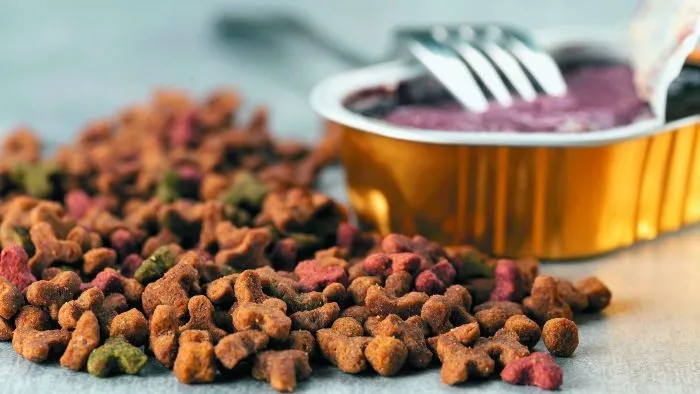
Dry vs. Wet Dog Food
Out of many questions in the dog food world while feeding them, one of the most important is “Dry vs. Wet Dog Food, Which is Better?” Well, there is no one perfect answer, dry or wet it all depends on the dog.
We must feed them as per their preference, size, and nutritional needs.📃 But to solve this confusion let’s understand both dry food and wet food in detail:
Dry Dog Food
Dry dog food is essential in muscle development and overall body function of dogs.
"Choose high-quality dry dog foods🐶🍽️ based on proteins like chicken, beef, or fish, this will provide them energy and support their digestion," says Dr Tiffany Tupler from PetMD.
You can choose whole grains and fibre sources like different healthy vegetables to feed them a balanced meal. Like protein and fibre, healthy fats are also important for skin, coat, and joint health.
Dry dog food has one super benefit, the dry texture of dry food and kibble improves their dental health as chewing this helps in the prevention of plaque and tartar buildup. 🦷
Chewing helps in oral hygiene and oral exercises as well. Dry dog food also has a longer shelf life compared to wet dog food, making it easier to store in bulk.
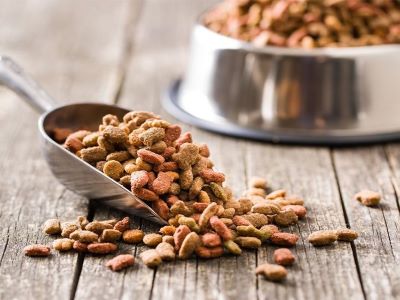
These are some benefits of dry food, and understanding this helps in making the right decision. With this let’s see what makes dry food, what does it contain?
How Is Dry Dog Food Processed?
Kibble is made from a specific process to ensure safety and balanced nutrition. Let’s see the process in detail:
- After choosing quality ingredients of meat, grains, vegetables and different supplements based on their nutritional value and flavour. Ingredients are ground into small, consistent pieces to ensure a balanced nutritional mix in each bite.
- The blend is cooked at high heat to kill bacteria and make the food more digestible, easy on the stomach and flavorful.
- The cooked mixture passes through a machine at high pressure to create a familiar kibble shape and crunchy texture.🐶🍽️
- Then the kibble is dried to reduce moisture and stop bacterial growth, giving it a long shelf life. Some kibbles are coated with oils or fats to make them more delicious to dogs.
- Strict quality control happens throughout to ensure the food is nutritious and safe. Then ready kibble is packaged to maintain freshness, and nutrients, and prevent environmental exposure.
Wet Dog Food
Wet dog food is high in moisture compared to dry kibble dog food, this is great for dogs who do not drink enough water on their own, this fulfils their hydration needs💧 and prevents issues due to dehydration.
Hydration is important to maintain smooth urinary health and kidney function[1]. Wet dog food also contains a good amount of protein for their other body function and growth. Protein also gives them energy and contributes to their skin and coat health.
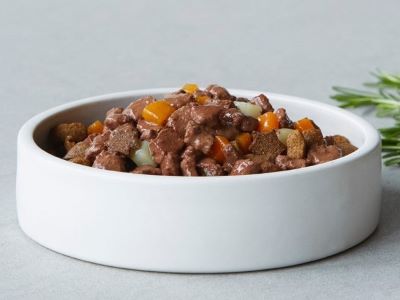
The delicious smell and meaty texture are great for dogs who are picky eaters, who like variety and do not eat the same food every day. The soft texture of wet food is good for dogs with dental issues, as this is easy to consume. Let’s see what is in the wet dog food:
How Is Wet Dog Food Processed?
Wet food goes through a special process to be palatable and balanced nutritionally to fulfil the dog’s needs. Let’s see the process:
- High-quality ingredients like meats, vegetables, and grains are carefully picked for nourishment and flavour.🐶🍽️
- Ingredients are ground into a fine texture to ensure consistent nutrients. The mixture is cooked at low temperatures to preserve moisture and enhance flavour while killing bacteria.
- Tasty broths or gravies increase moisture and appeal. The food is canned or pouched to seal in nutrients and prevent spoilage.🚫
- Sterilizing Cans and pouches is an important step here to remove any remaining bacteria. Strict quality testing occurs throughout for nutrition, taste, and standards.
- Then ready product is labelled and packaged to maintain freshness and goodness until opened by you, to feed your lovely dog!
Things to Keep In Mind While Choosing Dog Food
Let’s look at some points we must keep in mind while choosing foods for our dogs:
1. Dog’s Age and Health
Puppies need a diet rich in nutrients for their development, which includes high levels of proteins, fats, and essential vitamins. Adult dogs must have a balanced diet to maintain their health and energy levels.
Senior dogs may require lower-calorie foods to support their joint health and also take care of their age-related issues. Dogs with weight issues need food that will manage their weight and fulfil their nutritional needs.
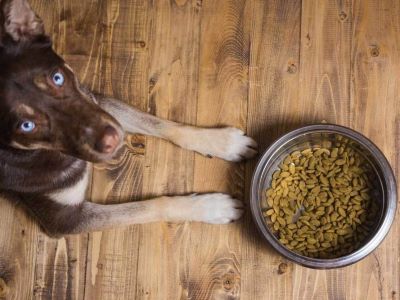
2. Cost Budgeting
While buying dog food compare prices of multiple brands to get the best deals. Consider cost per serving to figure out the long-term affordability.
Find out if there are any subscription plans for cost savings.💰 Understand the feeding guidelines given by food brands to take the maximum benefit for your dog’s energy and activity levels.
3. Your Lifestyle
Your lifestyle is very important in your dog’s life. Look at your daily schedule and figure out a time to prepare and serve him a meal. 🐶🍽️
Dry food is convenient for busy schedules due to its long shelf life and it is easy to serve, also for people who travel frequently. Wet food on the other hand needs some extra effort to maintain and serve them.
4. Combining Dry and Wet Dog Food
Wet or Dry? there is not one answer. Both of them have their advantages and flaws, but let’s combine them and see what happens:
- If we combine dry and wet dog food then it gives balanced nutrition to the dog. Dry kibble mostly provides higher protein, while wet food gives moisture, supporting hydration. Especially to the dogs who do not drink enough water.💧
- Make sure combining both foods fulfills their daily requirements such as activity and energy levels. You must adjust portions as per your dog’s age, weight and breed.
- You must also add some dental treats in their routine to give them variety and also for their oral health. They reduce the plaque and tartar buildup in their mouth.
- Schedule regular dental check-ups with your vet to watch your dog’s oral health. Professional dental cleanings every six months or as per your vet’s advice is a good idea.🦷
- Experiment with the ratio to find out your dog’s optimal amount to avoid upsetting their stomach or over-feeding. Keep this consistent to provide them with nutritional balance.
- In the beginning, after you feed them watch for their reaction. If you find any sign of allergy or discomfort then quickly consult with your vet. Always transition between foods gradually so that your dogs can adapt at their own pace.
- Lastly, we tend to forget water, so make sure your dog has access to fresh water every day. Hydration is important to maintain smooth digestion.
How to Pick the Best for Your Dog? Tips!
Let’s explore the most confusing question, enjoy the following points and sip your coffee!
Tip 1: Your Dog’s Preferences
Above all the tips and tricks main thing is to follow your dog’s preference and choice. You can figure this out by their happiness (wagging tail and trying to reach the shelf!) during mealtimes.🐶🍽️
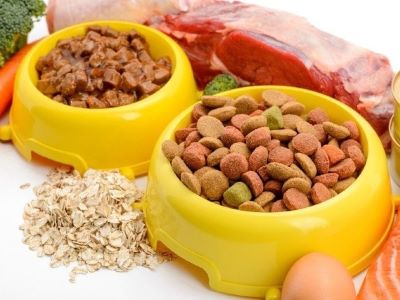
Also, with different dogs their nutritional choices are different too. Some breeds may have particular allergies and you must feed them accordingly.
Tip 2: Consulting with the Vet
Consulting with your dog is important, remember they are here to help you.🧑⚕️
No matter the issue just ping them quickly and ask questions, they are more than happy to help you out, one meal at a time!
Tip 3: Considering Age
Let’s see how can you choose food according to their age:
- Puppies: Choose puppy-specific instructions to support development. Puppies need high levels of protein and vital nutrients to build strong muscles and bones[2].
- Adults: Select a balanced adult dog food according to maintain their overall health. Consider your dog’s activity level and adjust calorie intake accordingly.🐶🍽️
- Seniors: Choose a senior dog food that fulfils specific ageing concerns such as joint health and lower metabolism. Senior dogs may benefit from extra supplements like glucosamine for joint support.
Tip 4: Ingredient Lists
While cruising through food stores, look for high-quality animal proteins such as beef, chicken, or fish as the primary ingredient. Protein is important for muscle development and other body functions./
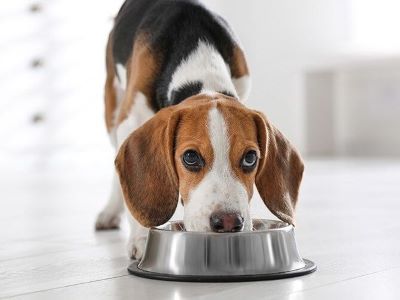
Choose food that provides the right balance of grains, fibre, and necessary vitamins & minerals. You can also ask your vet, they will suggest you foods with the food guidelines according to your dog’s breed and age.
Tip 5: Trial and error
First and foremost, when you are making any change in your dog’s diet consult with the vet first about the pros and cons.
Observe your dog’s reaction to the new food, are they excited? more energetic? or simply sleeping all day feeling lazy or maybe any sign of distress?
Also, follow their weight changes to keep track to not over-feed them. Give them time to adapt to the new change at their own pace, after all, you are doing this for their well-being only!
Common Myths and Facts
Let’s go through some myths and facts about dry and wet food, to understand this further in detail:
⁉️Myth: Wet Food is Always Better!
- Some pet owners believe that wet dog food is better than dry food, believing that it provides a more natural and nutritious choice.
✅Fact: Proper Balance is Key.
While wet dog food shows higher moisture content, it’s not better than dry food. Both wet and dry foods have their benefits and can be part of a well-balanced diet.
Right nutrition is about meeting individual dog needs, considering factors like age, health, and choices. A mix of wet and dry food may offer the benefits of both, texture and nutrition.
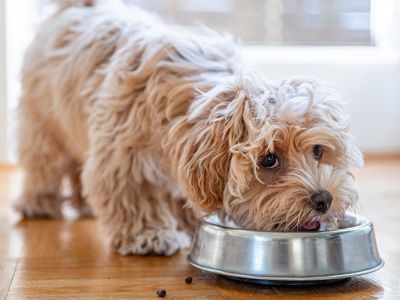
⁉️Myth: Dry Food Causes Dehydration!
- Some pet parents worry that feeding dry dog food only will lead to dehydration due to its lower water content.
✅Fact: Sufficient Water Intake is Crucial.
Dry food holds less water compared to wet food, but it doesn’t lead to dehydration. Dogs normally drink water to fulfil the lower moisture content in dry kibble.
Monitoring water intake is vital regardless of the food type to ensure proper hydration. Providing access to fresh water at all times is essential, especially for dogs on a dry food diet.
💡Interesting Insights:
Dogs, like us humans, have choices for different textures. Some dogs may enjoy the crunchiness of dry kibble, while others choose the softer texture of wet food.🐶🍽️
Mixing wet food with dry kibble can be a method to increase overall water intake. This is especially useful for dogs that may drink less water.
FAQs
❔What Should I Feed My Dog Wet or Dry Food?
Dry food may be better for dental health. There is some evidence to show that dry dog food may be better for dental health. It’s less ‘messy’, which is ideal if your dog tends to get overexcited at mealtimes. And of course, some dogs simply prefer crunchy or soft kibble to wet food!
❔Dry vs. Wet Dog Food, Which Is Better?
Both dry and wet food are legitimate dog food sources. Vets say wet is better for ease of eating, better hydration, and better satiety and palatability with fewer carbs. Meanwhile, dry food is better for convenience and oral health benefits at a much lower price point. A combo of both can also be ideal.
❔What Is the Healthiest Food to Feed Your Dog?
As a starting point, here are our top recommended dog treats that give the most health benefits: Cooked, Unseasoned Chicken, Turkey, or Beef. Cooked, Unseasoned Fish. Cooked, Unseasoned Eggs. Cooked Pumpkin. Cooked Green Beans. Cooked Carrots. Cooked Spinach. Sliced Apples, In Moderation.
❔What Is the Best Way to Feed a Dog?
Dogs should eat at least two meals each day, about 12 hours apart. But a breakfast, lunch, and dinner schedule is an equally great option. If more than 12 hours elapse between meals, the stomach can become acidic causing nausea.
❔What Is the Best Time to Feed a Dog?
You can feed your dog anytime between 7.00 a.m. to 9.00 a.m. in the mornings. If you have a young pup, you might want to stick to 7.00 a.m. to 7.30 a.m. so that you divide their portions equally 4 times a day. Answer: Ideally, a 12-hour gap is the recommended time between one adult dog meal to another.
Conclusion
In conclusion “Dry vs. Wet Dog Food, Which is Better?” There is no perfect choice. It all depends on your dog and his choices. 🐶🍽️
Understand the advantages and flaws of both dry vs wet dog food and provide your dog accordingly. Consult with your vet about your dog’s nutritional needs, they will guide you according to the dog’s breed, size, and requirements.
One food is not necessarily better than the other. Your dog depends on you to make the right choice so be careful, weigh the pros and cons then decide. After all a healthy dog is a happy dog!
Reference:
- Kidney Research UK. (2023, April 17). Hydration for kidney health | Kidney Research UK.
- Nutritional requirements of large and giant breed puppies | VCA Animal Hospitals.



